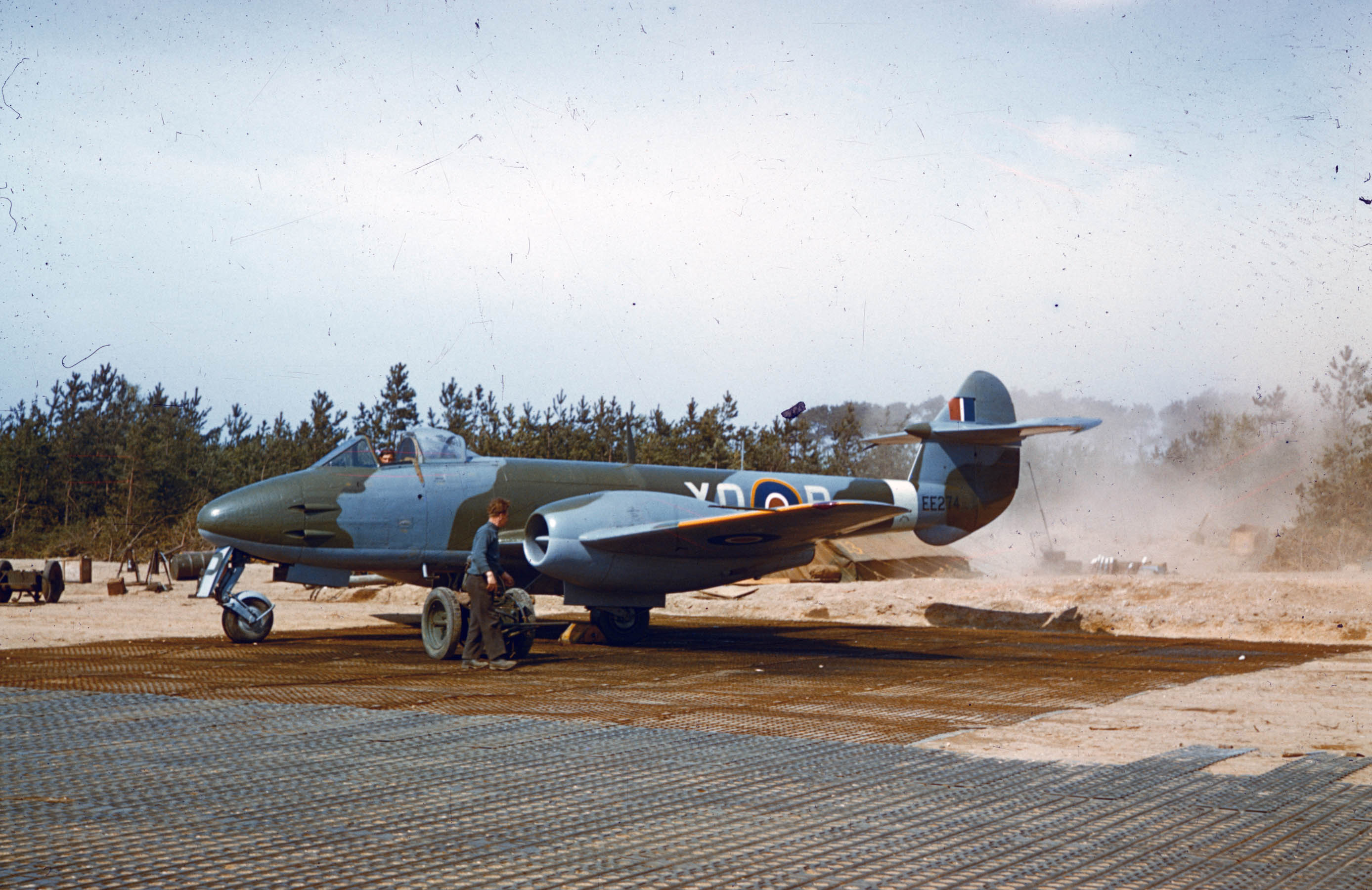Although Britain’s first operational jet never mixed it up with the Messerschmitt Me-262, the Gloster Meteor did take on a dangerous jet-powered opponent.
The first two confrontations between the jet-propelled aircraft of opposing air arms played out over the patchwork countryside of southern England on July 27, 1944. Those encounters were doubly unique in that only the British aircraft, Royal Air Force Gloster Meteor F.1s, had pilots. The others were German Fieseler Fi-103 ground-launched flying bombs, the infamous V-1s.
The British nicknamed the V-1 the “Doodlebug” or “Buzz Bomb.” The Germans called it the Vergeltungswaffe, or “retaliation weapon,” intended to cause maximum destruction and mayhem in metropolitan London. For the Luftwaffe it was a way of hitting back at the heartland of the Allies without risking its depleted bomber reserves.
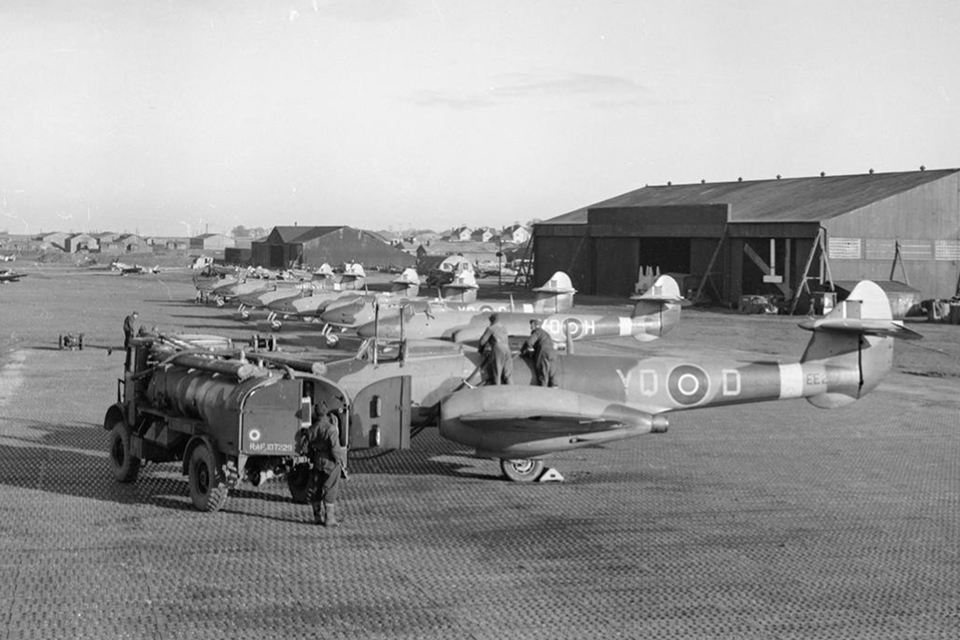
The engagements on July 27 were inconclusive. Meteor pilot Flying Officer T.D. “Dixie” Dean of No. 616 Squadron sighted a V-1 on a routine afternoon patrol. Before he could approach within cannon range, however, the flying bomb had entered the barrage balloon defense line, and he was forced to break off the attack. Squadron Leader Leslie Watts, also of 616 Squadron, had no better luck when, after catching up with a V-1, his cannons jammed when he tried to open fire.
The Meteor—“Meatbox” in RAF slang— was a comparative latecomer to this new type of aerial warfare. Prior to its introduction, “Diver” (the code name for flying-bomb attack) patrols, which began on June 12, 1944, had been dominated by the RAF’s Hawker Tempest, Griffon-engine Spitfire XIV and Mustang squadrons, with de Havilland Mosquitos operating at night.
Their quarry, the midwing monoplane V-1, was the forerunner of today’s land-based cruise missiles. Built mainly from sheet metal, this diabolical weapon could be assembled in as little as 50 man-hours. Powered by an Argus pulse-jet engine using 150 gallons of fuel with compressed air as the oxidizer, it had an estimated range of 130 miles. Gyroscopes linked to an autopilot provided directional control. In the nose was 1,875 pounds of high explosive, set to detonate on impact after the V-1’s propeller-driven distance log had automatically deflected the elevators to dive the bomb, simultaneously cutting off the engine’s fuel supply through the sudden application of negative G.
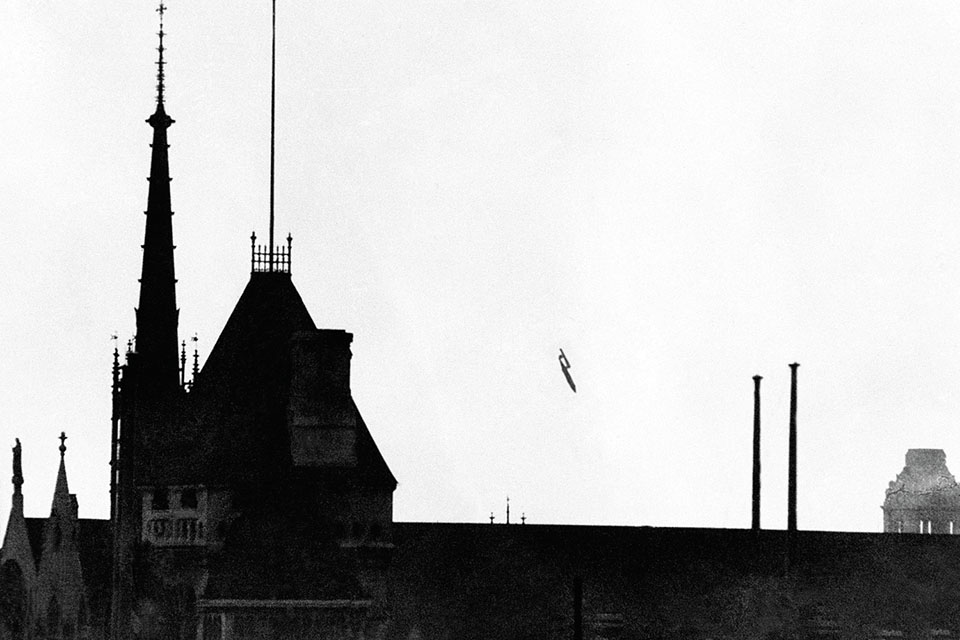
At 27 feet long, with a wingspan of just under 18 feet, the V-1 presented a relatively small target for intercepting fighters. Flying at 350-400 mph between 3,000 and 4,000 feet, it could operate in all weather conditions and of course at night. The V-1’s dark green camouflaged upper surfaces made it difficult to spot against the rural landscape, although its glowing pulse-jet helped with sighting. However, the V-1s took only 20 minutes to fly from their main launching sites in the Pas de Calais to London. This gave alerted fighter pilots a window of only five or six minutes from the time the missiles crossed the coast to position themselves to intercept the V-1s before they entered the zones defended by anti-aircraft guns and barrage balloons, up to 2,000 of which were deployed in a defensive line between Gravesend and Biggin Hill.
Destroying the V-1s was certainly no “turkey shoot.” Although the flying bomb could not defend itself, its high-explosive load posed a real threat to pilots who attacked from close range with cannon fire. Several RAF pilots were killed in the resulting fireballs, while others had the fabric stripped off their airplanes’ control surfaces. As an alternative to shooting the missiles down, Tempest pilots had found that the V-1s could be downed by flying in front of them and using the slipstream to topple the missile’s gyroscopic guidance system. The same result could be achieved by flying alongside and disturbing the boundary layer under the wing.
Twin-engine Meteor F.1s, derived from Britain’s pioneering turbojet aircraft, the Gloster E.28/39, were the first jets to serve operationally with the RAF. The initial batch was delivered to 616 Squadron on July 12, 1944, replacing its trusty Spitfire VIIs. Several weeks earlier, Wing Commander Andrew McDowall, a Battle of Britain ace, and five other pilots had been sent to Farnborough to convert to the Meteor as the precursor to 616 Squadron becoming operational with the jet fighter. The former CO of 616, Squadron Leader Watts, stayed on as a flight commander. Other pilots joined them later.
Conversion to the Meteor proved relatively uncomplicated for these experienced fighter pilots, who quickly became accustomed to the lack of torque from the two Rolls-Royce W2B/23C Welland turbojets, the slower acceleration and the tricycle undercarriage. The F.1 had a top speed of 415 mph at 3,000 feet. Armament was four nose-mounted 20mm Hispano cannons.
Declared operational on July 27, 616 Squadron was then based at Manston, near the northeastern tip of Kent. To extend the Meteor’s range, however, the squadron tended to fly mainly from a satellite airfield at Ashford, almost directly beneath the track usually followed by V-1s inbound from Calais.
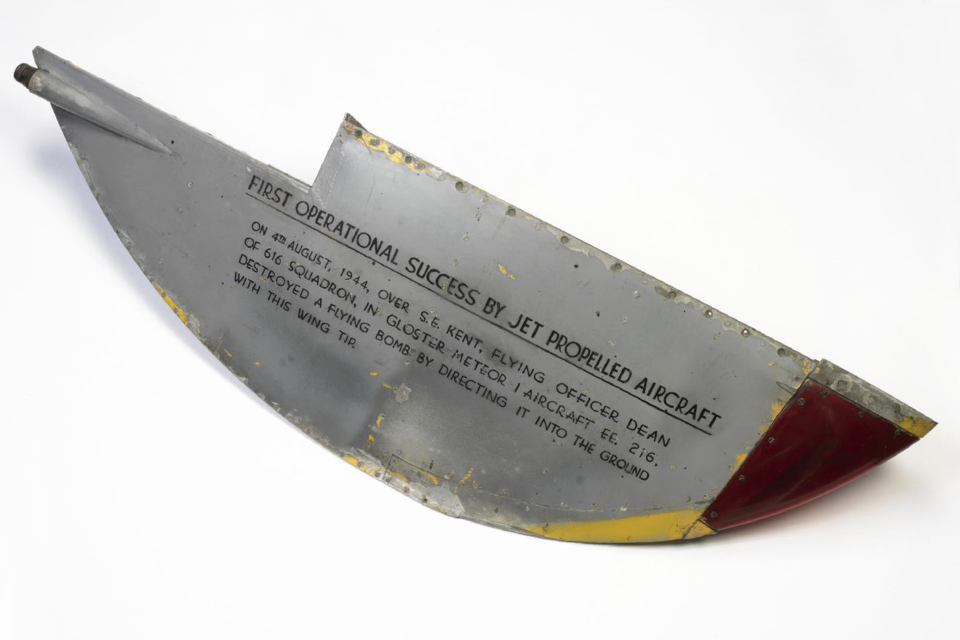
On August 4, Dean became the first British pilot to record a victory in a jet fighter when he dived from 4,000 feet at 450 mph to make a head-on cannon attack on a V-1. When his guns jammed, Dean turned and rapidly overtook the missile to position the Meteor’s port wing under the V-1’s. He then flew alongside until the disturbed air caused the V-1’s gyro to topple, sending the missile plunging down to explode in the countryside. Later that day, Flying Officer J.K. Rodger became the first RAF pilot to actually shoot down an enemy aircraft from a jet fighter when he destroyed a V-1 with cannon fire near Tenterden, southwest of Ashford. Dean destroyed a V-1 with cannon fire on August 6, followed by another near Ashford two days later.
The squadron suffered its first Meteor fatality on August 15, when Flight Sgt. D.A. Gregg crashed on approach to landing. The next day Flying Officer William McKenzie, a Canadian, toppled a V-1’s gyro with the wing-under technique, while a Belgian, Flying Officer Prule Mullenders, destroyed another with cannon fire. Six more V-1s were accounted for by 616 between August 17 and 28, with another shared by a Tempest pilot on the 29th, taking the squadron’s total to 12½. By this time advancing Allied ground forces had captured most of the French launching sites, although Diver patrols continued.
The Germans attempted to keep up the momentum of their terror campaign with air-launched rocket-propelled missiles fired from over the North Sea at the eastern counties of England from Heinkel He-111 mother ships. But these never achieved the same concentrated impact of the earlier V-1 attacks on London, finally petering out in late March 1945, six weeks before Germany surrendered.
By this time, 9,251 flying bombs had been launched against Britain, of which 2,419 evaded the fighters, gunners and balloons to land on London. The missiles killed or injured almost 23,000 people and reportedly destroyed or damaged more than a million homes. The RAF was credited with destroying 1,979 flying bombs, with one pilot alone, Squadron Leader Joe Berry of No. 501 Squadron, accounting for 59. Although the contribution of 616 Squadron’s Meteors to Diver patrols was slight, the RAF had gained experience that propelled the jet fighter into the next stage of its operational career.
A separate menace, against which there was absolutely no defense, was the 3,580-mph V-2 rocket, 1,115 of which were fired at Britain between September 1944 and March 1945. Carrying 2,200 pounds of explosive, the V-2 could reach London in about three minutes.
Meanwhile, having encountered the Luftwaffe’s Messerschmitt Me-262 jet fighter and rocket-powered Me-163, the crews of the USAAF’s B-17 and B-24 bombers were keen to develop combat techniques for dealing with these new threats. Four Meteors were therefore detached to Debden in October 1944 for trials simulating attacks on box formations of USAAF bombers and their P-51 and P-47 escorts. Timing proved crucial because initially the Meteors were making hit-and-run passes at the bombers at 450 mph, which quickly carried them out of the escorting fighters’ range. Those exercises helped U.S. aircrews formulate new defensive tactics, including stationing the escorts some 5,000 feet above the bombers so they could roll into a high-speed dive to intercept the jets. RAF air and ground crews also benefited, not least in making field improvisations to keep the Meteors operational.
Partially re-equipped with Meteor F.3s, the later models of which were fitted with more-powerful Rolls-Royce Derwent engines, 616 Squadron went to war again in early 1945, this time on mainland Europe as part of the Second Tactical Air Force. Initially a detachment of four pilots, four aircraft and ground crews was based at Melsbroek, Belgium, with strict instructions not to fly over enemy territory. Even at this late stage in the war, the RAF was reluctant to risk the jet falling into German hands. To avoid misidentification by Allied gunners and aircraft, the detachment’s Meteors were initially painted white.
Although the Meteor pilots were eager to take on the vaunted Me-262, the nearest they got to a jet-to-jet encounter was on March 19, 1945, when two Arado Ar-234 jet bombers dropped fragmentation bombs on the airfield, damaging one Meteor.
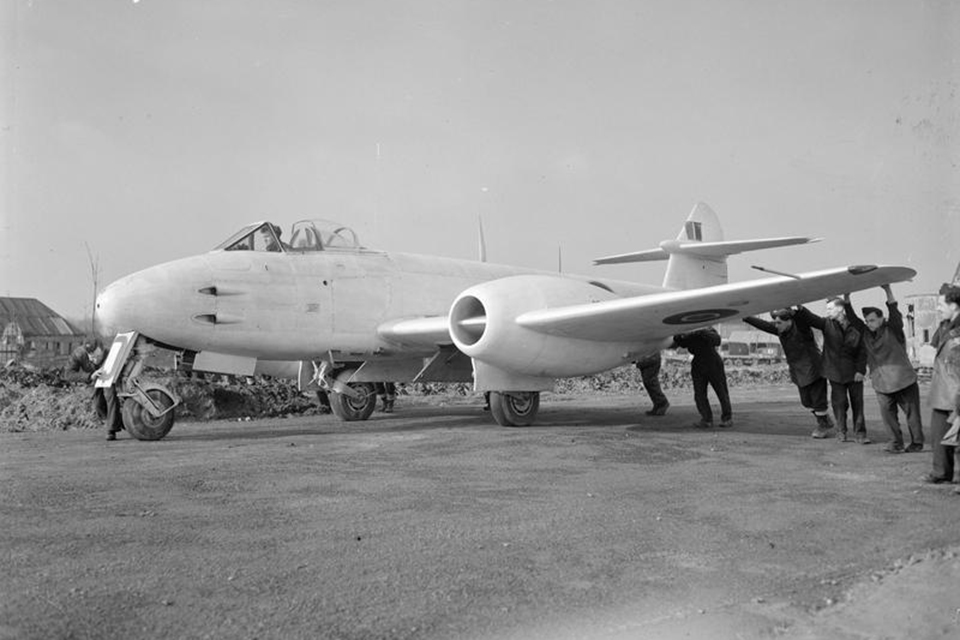
On March 26, the detachment relocated to Gilze-Rijen in Holland, where the rest of the the squadron joined it. By this time, with war’s end edging closer, the restrictions on overflying enemy territory had been relaxed and, on April 3, the Meteors scrambled for the first time to intercept enemy aircraft. Disappointingly for the eager pilots, the alert was a false alarm.
As the Allied advance continued, 616 Squadron moved to Kluis, near Nijmegen, preparatory to making daylight strafing raids on enemy airfields, ground transport and military installations. The first such “Rhubarb” sortie to achieve success came on April 17, when a Meteor destroyed a German truck near Ijmuiden. Four days later, Meteors strafed Nordholz airfield, destroying a Junkers Ju-88 on the ground. A week later, 616 lost Squadron Leader Watts and his wingman, Flight Sgt. Brian Cartmel, when their Meteors collided in a cloud during a reconnaissance sortie.
Operating from Luneberg, Germany, in the final days of the war, the Meteors carried out numerous ground-attack missions in support of the Allied armies. On May 3, the new CO, former Tempest pilot Wing Cmdr. Warren Schrader, and Flight Lt. Tony Jennings attacked Schonberg airfield, destroying two Ju-87s, two He-111s and an Me-109 on the ground. During the same sortie, Jennings almost scored the Meteor’s first aerial victory over a piloted aircraft when he found a Fieseler Fi-156 Storch communications plane. Spotting the Meteor, the German crew used the Storch’s remarkable STOL qualities to land and evacuate their plane, leaving Jennings to destroy it on the ground with cannon fire. Two days later the war in Europe ended.
The Meteor pilots never did encounter the Me-262. This was probably just as well because, according to legendary Royal Navy test pilot Captain Eric “Winkle” Brown, who flew both types, in capable hands the faster, punchier German jet would have “made cat’s meat” of the British plane.
Although the first Meteors to see combat made no significant impact on the war effort, either as Doodlebug-chasers or with the Second Tactical Air Force in Europe, they undoubtedly provided the RAF with important operating lessons that facilitated the service’s transition into the jet age. The Meteor in upgraded versions would reprise this introductory role for many of the world’s other air forces, including operationally with the Royal Australian Air Force during the Korean War. Meanwhile, on November 7, 1945, a Meteor F.4 established the first postwar aircraft speed record of 606.25 mph.
The faithful Meatbox would serve on in the RAF and in other air forces well into the 1950s and beyond.
RAF veteran Derek O’Connor, who writes from Amersham, Bucks, UK, experienced firsthand the devastating effects of the V-1 attacks. He dedicates this article to the memory of his friend Eric Myhill, an ex-RAF Meteor pilot who recently died. Further reading: Meteor, by Bryan Philpott, and Flying Bombs Over England, by H.E. Bates.
Originally published in the March 2012 issue of Aviation History. To subscribe, click here.

